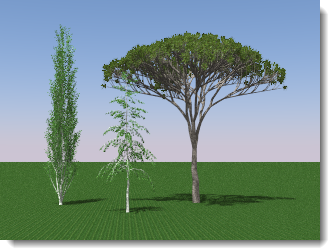 Plants
Plants
Flamingo nXt includes a fun and powerful plant generator that efficiently generates complex plant forms during rendering. These plants have little impact on model size, since only a placeholder is kept in the model.
 Flamingo nXt plants.
Flamingo nXt plants.
Insert an nXt Plant
Flamingo Plants are inserted as a block. These blocks contain points that represent the general shape of the plant.
- On the Flamingo nXt menu, click Plants > Insert Plant.
- In the Flamingo nXt Plant dialog box, click a plant name, and click Open.
- At the prompt, pick a location for your plant in the model.
Notes:
- Make sure the units are set correctly for your model.
- Plants can be scaled, copied, and rotated.
Edit a plant
You can move, copy, and scale a plant once it is inserted. The plant will resize appropriately. For more advanced edits to that plant structure, use the Edit plant command. Making small changes to the plant structure can be quick. Larger changes to the plant algorithms can take more experimentation.
- On the Flamingo nXt menu, click Plants > Edit Plant.
- Select the plant to edit.
- Make the correct edits to the plant.
- Save the plant, then close the editor. The plant in Rhino will automatically update.
Using Flamingo 2 plants
- On the Flamingo nXt menu, click Plants > Insert Flamingo 2 Plant.
- In the Flamingo nXt Plant dialog box, click a plant name, and click Open.
- At the prompt, pick a location for your plant in the model.
Notes:
- Models with Flamingo 2 plants already inserted should work with some restrictions.
- Flamingo 2 plants are different from the new plants. Currently you cannot edit Flamingo 2 plants or convert them to Flamingo nXt plants.
Plant Editor
Flamingo includes a plant editor to create custom plants. There are a few basic plant templates that can be used as a starting point for a new plant type. For details see the Plant Editor topic.